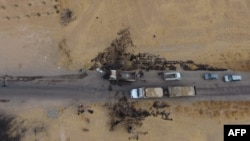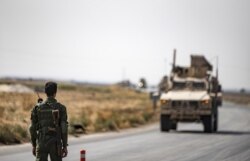Senior Islamic State leaders in Syria are coming under fire, part of what appears to be an urgent campaign to gut the terror group’s brain trust.
The U.S.-allied Syrian Democratic Forces – credited with helping to take out IS leader Abu Bakr al-Baghdadi and IS spokesman Abu Hassan al-Muhajir – said Monday it had carried out a series of raids aimed at getting the terror group’s key players dead or alive.
“Another successful raid targeting & arresting senior ISIS members,” SDF spokesman Mustafa Bali tweeted, using an acronym for the terror group, which is also known as IS or by its Arabic acronym, Daesh. “Those who are not killed will be arrested. Crimes of Daesh terrorists will not go unpunished.”
Details have been scarce, though SDF officials on Tuesday confirmed one operation in the town of Jarablus, the Turkish border, where the IS spokesman was killed.
The London-based Syrian Observatory for Human Rights cited sources as saying drones flew over the area before low-flying helicopters swooped in. It said the target of the operation was an Iraqi family.
SDF also confirmed it carried out a second operation in Afrin.
Later Tuesday, President Donald Trump tweeted, "Just confirmed that Abu Bakr al-Baghdadi’s number one replacement has been terminated by American troops. Most likely would have taken the top spot - Now he is also Dead!"
U.S. officials said Trump was referring to the IS spokesman, whose death was first announced by the SDF on Sunday and then confirmed by a senior State Department official Monday.
The official, speaking on the condition of anonymity, also told reporters the U.S. has been in close contact with SDF leadership, including General Commander Mazloum Abdi.
“We have been in close touch with him [Abdi] about all aspects of what we're doing,” the official said. “His people and his intelligence sources play a key role in all of this.”
U.S. Defense Secretary Mark Esper on Monday lauded the U.S. raid that killed Baghdadi as a “devastating blow for the remnants of ISIS” and promised that the United States would continue to be in close contact with the SDF.
US, SDF relations
Relations between the United States and the mainly Kurdish Syrian Democratic Forces have been strained since U.S. President Donald Trump ordered U.S. Special Forces to withdraw from parts of northeastern Syria earlier this month. Once the U.S. troops began to vacate key outposts near the Syrian-Turkish border, Turkey launched an assault targeting the Kurds, many of whom it views as terrorists with links to groups inside Turkey.
But SDF officials Monday said that cooperation with the United States in the weeks and months leading up to the raid on Baghdadi’s compound in Idlib province had been intense though the Turkish incursion caused the operation to be delayed by more than a month.
“Since 15 May, we have been working together with the CIA to track al-Baghdadi and monitor him closely,” senior SDF adviser Polat Can said on Twitter.
Can said the SDF had been tracking the IS leader for months, watching him as he moved from Dashisha, in eastern Syria, to Deir el-Zour, before finally making a move to the compound near the Turkish border where he met his end.
“Our own source, who had been able to reach al-Baghdadi, brought al-Baghdadi’s underwear to conduct a DNA test and make sure (100%) that the person in question was al-Baghdadi himself,” Can said of the access the SDF spy was able to get. “Our intelligence source was involved in sending coordinates, directing the airdrop, participating in and making the operation a success until the last minute.”
A U.S. official confirmed to VOA that Baghdadi, who died after detonating a suicide vest when he was cornered in a tunnel under the compound, has been buried out at sea.
WATCH: Baghdadi Raid
Evidence collected
IIn the meantime, U.S. officials are starting to sift through material and other evidence collected at the compound before it was destroyed in an airstrike.
"There was material taken away. I don't want to say exactly what or how much," General Mark Milley, the chairman of the Joint Chiefs of Staff, told Pentagon reporters.
Milley also confirmed two IS members, both men, were taken alive.
“They're in our custody," he said.
Milley said the United States has both photos and video of the Baghdadi raid, and that some of them could be declassified and released to the public in the coming days.
Steve Herman and Ken Bredemeier contributed to this report.













